The peace movement is definitely alive and well in New York State. Here’s the latest.
Guantanamo Vigils

Vigils to close the detention center at Guantanamo, Cuba continue the first Wednesday of every month outside the main branch of the New York Public Library in New York City. We appeal to passersby to remember and put pressure on our government officials to fulfill past promises to make that closure a reality. We speak; sing; and pass out fliers with information, statistics, and suggested actions. Join us in calling the White House to demand the closure of Guantanamo Detention Center now.
Ceasefire Vigils
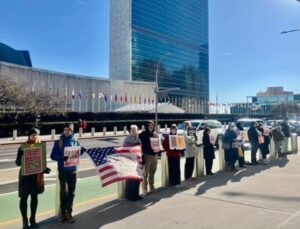
Every Thursday, there is a mid-day vigil for a ceasefire in Gaza and Israel, and now the West Bank, Lebanon, Syria and throughout the region, at the U.S. Mission to the UN across from the UN. People stand in silence facing the Mission with banners, signs, and baby dolls representing the Palestinian babies bloodied and killed. Pax Christi members faithfully lead this Vigil sometimes small and sometimes large.
End Endless War Rally & March
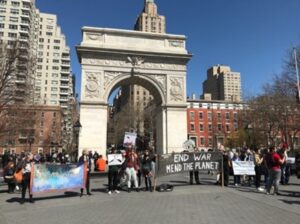
On March 19th, the 22nd anniversary of the war on Iraq, we joined War Resisters League (WRL), Peace Action, and other allies at Union Square to appeal to the public and our government to end endless war. We held signs, sang, and distributed a flier spelling out how “war is a failed priority.” The flier also listed several actions people can take. We then marched to Washington Square Park where we continued extending our message.
Hands Off! March

Despite the rain, Pax Christi New York State (PCNYS) members joined tens of thousands of marchers at the April 5th Hands Off! March from Bryant Park to Madison Square Park, crowding all the lanes of Fifth Avenue from sidewalk to sidewalk and stretching without a break from 42nd Street to 23rd Street. Messages varied widely, but addressed support for peace in Gaza, release of Israeli hostages, migrants at home, social security, Medicare and Medicaid, environmental protections, and much more. Similar marches and rallies happened across the state and the country, and Pax Christi members were there.
World Day of Prayer for Peace in Sudan
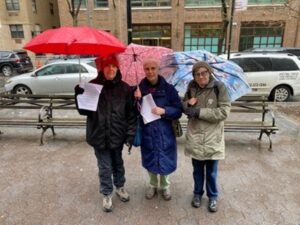
The war in Sudan gets far less attention than other conflicts raging across the Earth, but it has been described as the worst humanitarian crisis in the world. With that in mind, PCNYS joined Pax Christi International (PCI) in the World Day of Prayer for Peace in Sudan on April 11th, another rainy day. A few of us stood across from the Sudan Mission to the UN to pray while many others prayed from wherever they were. You can continue to offer prayers as the crisis in Sudan only worsens.
Tax Day

Annually, PCMNY and now PCNYS stand with WRL and others to say no to paying taxes for war and to inform passersby where their tax dollars actually go, often not in a proportion that they realize or want. We share that information with a WRL pie chart, our signs, banners, and song lyrics shared outside the IRS office in lower Manhattan.
Also on Tax Day, Pax Christi Upstate New York under the leadership of PCNYS Councilmember Jack Gilroy helped organize a student protest that directly confronted Lockheed Martin, BAE, the Watson School of Engineering, and the office of the Binghamton University President. Students organized a 17-car caravan starting at Lockheed Martin in Owego, NY, delivering a letter of incrimination to the CEO of Lockheed Martin and the plant manager. They then drove 12 miles to BAE Systems in Endicott where they set up banners along the sidewalk. Local TV interviewed some students. Ignoring warnings not to proceed, about 20 of the students walked passed security and gained entrance to the BAE building. There they left letters on the receptionist’s counter, the same letters that were sent as certified mail to all four recipients named above. The caravan then drove across the Susquehanna River to Binghamton University, where they hand-delivered letters to the president’s secretary and gained entry to the dean’s office of the Thomas Watson School of Engineering. Their letter demanded an end to the school’s role as an incubator for Lockheed Martin, BAE, and other industries that design and make instruments of death instead of focusing on the real needs of people. The letters were designed by Ohio attorney Terry Lodge and edited by students. See the links below for more about this Tax Day protest.
- https://www.wbng.com/2025/04/15/protests-held-against-lockheed-martin-bae-systems-binghamton-university/
- https://www.google.com/search?q=binghamton+university+students+protest+on+tax+day&rlz=1C5MACD_en&oq=bing&gs_lcrp=EgZjaHJvbWUqBggCECMYJzIPCAAQLhhDGLEDGIAEGIoFMgYIARBFGDkyBggCECMYJzIGCAMQRRhAMgYIBBBFGDsyBggFECMYJzIPCAYQLhhDGLEDGIAEGIoFMgwIBxAAGEMYgAQYigXSAQk3NjIyajBqMTWoAgiwAgHxBQUwRxyJVXuC8QUFMEcciVV7gg&sourceid=chrome&ie=UTF-8
The Nevada Desert Experience Sacred Peace Walk

For many years, including this year, PCNYS Councilmember John Amidon of PC Upstate NY has participated in the Nevada Desert Experience Sacred Peace Walk over Holy Week. He and his fellow walkers completed their 60-mile pilgrimage from Las Vegas to the Nevada National Security Site at Mercury, Nevada on Good Friday. That morning Western Shoshone Spiritual Person Johnnie Bobb held a traditional sunrise ceremony. The day continued with vigiling, breakfast, tunnel painting, and the Stations of the Cross. Then, about 1:15 pm, the 32 walkers proceeded to the Nevada National Security Site (NNSS) gate where the Nye County Sheriff’s Department greeted the walkers civilly. After the walkers gave several important messages concerning the criminal activities of the NNSS, including nuclear weapons development and testing, the illegal occupation of the Western Shoshone homeland, the continued misuse of resources and pollution of the land and environmental destruction, three peace walkers crossed the line. Nathan Jerrell of Las Vegas, Karen Pettit of Las Vegas, and Jon Klusmire of Bishop, CA received citations for trespass and 60 days to reply. Tragically, the urgency to disarm nuclear weapons is growing daily. Watch a video of why they walk here: https://www.youtube.com/watch?v=MkaI2Oh6V1k
Good Friday Way of the Cross, April 18th, 2025
For the 43rd consecutive year, PCMNY held its Good Friday Way of the Cross across Manhattan. This year’s theme was “In a time of polarization and conflict, how do we follow the path of Jesus?” Fifteen different groups applied this theme to 15 Stations reflecting on Jesus’ passion and praying in repentance and petition for the ways he continues to suffer in the world today. Special thanks to Hideko Otake for her photos and videos of this year’s Way of the Cross.
- https://photos.app.goo.gl/kAJMtyxxnM6nfbU28
- https://youtu.be/nPAQQpKZq-M, https://youtu.be/FZLndDVDjRU
- https://youtu.be/z8iAK_KbtcE.
Silent Vigils for Gaza

On April 24th, there was a special vigil for Palestine in front of the U.S. Mission to the UN across from the United Nations. The focus was the children of Gaza who are starving to death. The ongoing call is for an end to the deadly policies that are leading to famine, for an arms embargo, and for peace. Two days after this Silent Vigil, the Mission of the Holy See to the UN offered a Memorial Mass in honor of Pope Francis. Members of Pax Christi chose to honor Pope Francis, as well. In silence, with sign and banner, we shared one of His Holiness’s last messages before he died, calling for peace in Gaza.
Dorothy Day Pilgrimage

Later that same day, April 26th, PCNYS sponsored a Dorothy Day Pilgrimage led by Jodee Fink of the Dorothy Day Guild. The Pilgrimage is a walk through lower Manhattan where Dorothy spent much of her time, where she discovered her Catholic faith at St. Joseph’s Church, protested for women’s rights, worker rights, and peace, and spent time in jail, where she co-founded the Catholic Worker with Peter Maurin, wrote and published the Catholic Worker newspaper, where both Mary and Joseph Catholic Worker Houses are to this day, where she lived and where she died. Dorothy was a significant contributor to the founding of Pax Christi in the U.S., so she holds a special place in our hearts.
50th Anniversary of the Vietnam War
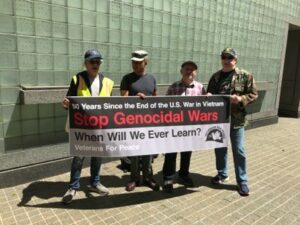
Members of PCNYS joined Veterans for Peace on the 50th anniversary of the end of the Vietnam War at the Vietnam War Memorial in lower Manhattan, NYC. We listened to poignant stories from Vietnam War veterans whose war experiences converted them to being the peacemakers they are today, and we heard the very emotional testimonies of a veteran father and his adult son who recently visited Vietnam on a delegation of peace.
Mother’s Day

Actually on the eve of Mother’s Day (not Mother’s Day itself, but in honor of the Day), PCNYS’s Jack Gilroy again was a force behind yet another creative action to teach peace. This time it was a Concert for Peace that included a presentation of the original 1870 Mother’s Day Proclamation, which is a cry for peace, by actor Narani O’Shaughnessy taking on the role of Julia Ward Howe; a performance by Michael McGurane singing the 1915 classic, “I Didn’t Raise My Boy to Be A Soldier (to kill some other mother’s loving boy);” and Jim Clune reciting the ballad of Willie McBride, sometimes called “The Green Fields of France,” a sad chant of the misery and stupidity of war. The event, which took place in Otsiningo Park in Binghamton, NY, preceded a Silent Peace Walk for Child Victims of War from Ukraine to Sudan to the Middle East. Watch the concert here: Concert for Peace – Save Gaza – 5- 10- 25.
Nakba Day
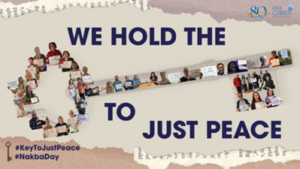
This Nakba Day, PCI invited our global community to join a collective action of memory, witness, and hope. In remembrance of the Nakba, the mass displacement of over 750,000 Palestinians in 1948, PCI called on people around the world to hold up a simple symbol: the key. A key to a lost home. A key to dignity. A key to Just Peace. Through this campaign, they asked us to share on May 15th a photo of ourselves holding a physical key and the campaign’s poster as a personal act of solidarity amplifying voices calling for truth, memory, and the right of return. The ultimate message: Together, we hold the key to a future rooted in justice, human rights, and lasting peace.
Gaza Fast

On May 22nd, a coalition of military veterans, religious and humanitarian organizations began a 40-day “Veterans & Allies Fast for Gaza,” with a news conference at 10:00 am ET, at the “Isaiah Wall” near the United Nations headquarters in New York City, moving to the U.S. Mission to the UN, where the fast is being conducted. The demands of the fast are 1) Full humanitarian aid to Gaza under UN authority and 2) No more U.S. weapons to Israel. A representative number of people are fasting from May 22 to June 30 in New York, They are limiting themselves to 250 calories per day, which has been reported as the average intake for people in Gaza. Hundreds more are participating around the U.S. and beyond for as many days as they can in a variety of ways, including fasting Ramadan-style between sunrise and sunset, skipping a meal a day, or consuming a liquid-only diet. They are doing so for a day, several days, a week, or more. The fast is organized by Veterans For Peace along with 28 co-sponsoring organizations, including Pax Christi USA (PCUSA). Friends of Sabeel, NA is maintaining the list of fasters. A statement from the fasters condemned the genocide, saying, “We are horrified and outraged that Israel is using starvation as a war tactic in clear violation of international law, and we condemn our government’s complicity in the genocide of the Palestinian people.” Read about and watch the launch of the Fast here:
- https://wordandway.org/2025/05/23/christian-activists-and-veterans-start-40-day-fast-for-gaza/
- http://www.radio4all.net/files/[email protected]/2025-05-22%20Essential%20Dissent%20-%20Veterans%20&%20Allies%20Fast%20for%20Gaza%20005900%20-24%20LUFS.mp3
- https://www.youtube.com/watch?v=MVEDU-X9bM0&t=840s”
Memorial Day

Pax Christi Long Island (PCLI) held its annual Peace Vigil the Saturday before Memorial Day at the Jones Beach Air Show which features the Air Force Thunderbirds and an aggressive military recruitment effort. The PC Long Islanders’ goal was simply to encourage beachgoers to remember that the real reason for Memorial Day is to grieve those who had to sacrifice their lives in war and NOT to celebrate the war machines that do the killing. They also highlighted that the Air Show is a recruiting tool for the US military. They displayed pictures of Long Island soldiers killed recently in the Iraq and Afghanistan wars and asked people to work for peace so no more young people needlessly have to die. Their vigil included prayer, distribution of over 500 handouts, and conversations with interested beach goers. An article about the action appeared in the local paper, Newsday.
Catholic Conscientious Objector Registry
In the spirit of opposing war and supporting peace, PCNYS has been working with PCUSA to develop a Conscientious Objector Registry for Catholics. We are happy to report that the PCUSA National Council has approved this initiative. We’ll have more information by our next website update.
In the News:
PCLI has also gotten attention in two Suffolk County newspapers: The LI Advance and The Suffolk County, as well as on line at the Pressenza website, https://www.pressenza.com/2025/03/mary-beth-moore-and-evelyn-lamourreux-we-must-protect-our-immigrants/. The article by two PCLI members states: “We Must Protect Our Immigrants.” On the same theme, and by one of the same authors, Sr. Mary Beth Moore, is yet another Newsday article sharing our new Pope’s affinity for immigrants. Sr. Mary Beth had the privilege of meeting Pope Leo XIV when they were both ministering in Peru.
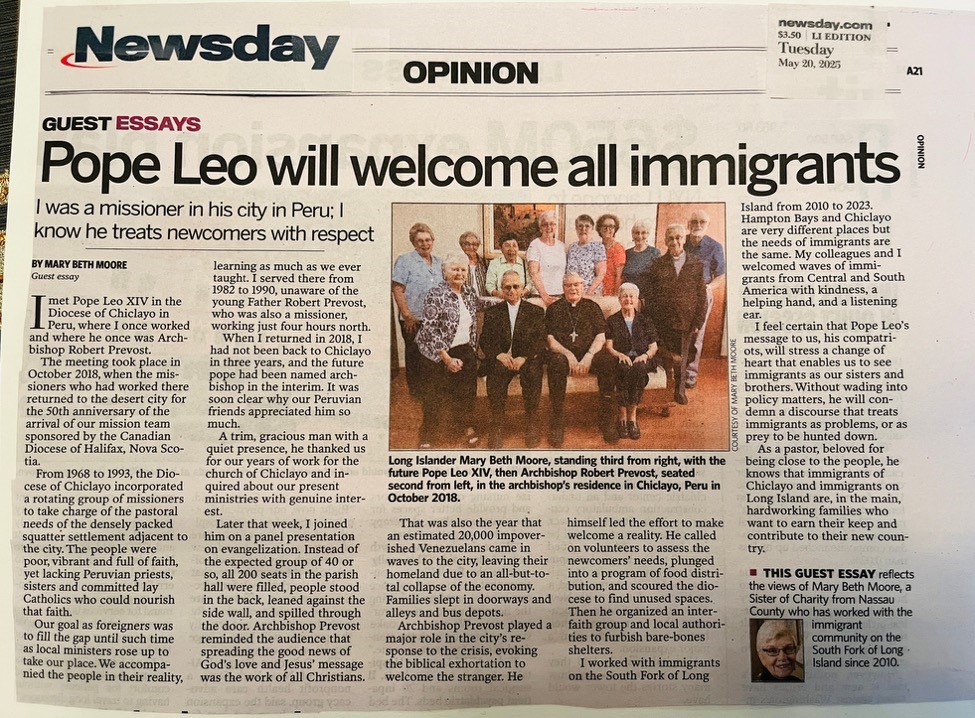
Book Review
PCNYS Coordinator, Rosemarie Pace, reviewed a book she highly recommends, Portraits of Peacemakers: Americans Who Tell the Truth by Robert Shetterly. In these dark times, it’s both inspiring and uplifting. The review is published in the Journal of Social Encounters and can be read here: https://digitalcommons.csbsju.edu/cgi/viewcontent.cgi?article=1348&context=social_encounters
Finally, over the past few months, PCNYS has co-sponsored, endorsed, or signed onto the following:
- the “Stand Up for Sudan Act”
- the House Joint Resolutions of Disapproval opposing $12.5 billion in Trump Administration Weapon Sales to Israel
- Opposition to Mike Huckabee’s Nomination for Ambassador to Israel
- House Resolution Recognizing the Nakba and Palestinian Refugees’ Rights
- Joint Statement: Genocide Returns to Darfur
- Statement by Manhattan Project for a Nuclear-Free World for the Third Preparatory Committee for the Non-proliferation Treaty (NPT)
- FY2026 Request to End Department of Interior Fossil Fuel Approvals
- Unified Call to Confront Famine in Gaza: Launch the Diplomatic Humanitarian Convoy Now
- Amicus Curiae Brief of Interfaith Groups in Support of Petitioner Mahmoud Khalil’s Petition for Writ of Habeas Corpus and Motions for Release, Return, and a Preliminary Injunction
- S.J. Res 51, 52, and 54 to block several major arms sales to the government of the United Arab Emirates (UAE) in light of extensive evidence of UAE support to the Rapid Support Forces’ killing of civilians in Sudan